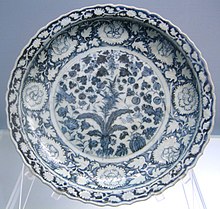
Back صحن Arabic Platu AST Orakan ATJ Chuwa Aymara Boşqab Azerbaijani بوشقاب AZB Tuorielka BAT-SMG Plato BCL Талерка Byelorussian Талерка BE-X-OLD



A plate is a broad, mainly flat vessel on which food can be served.[1] A plate can also be used for ceremonial or decorative purposes. Most plates are circular, but they may be any shape, or made of any water-resistant material. Generally plates are raised round the edges, either by a curving up, or a wider lip or raised portion. Vessels with no lip, especially if they have a more rounded profile, are likely to be considered as bowls or dishes, as are very large vessels with a plate shape. Plates are dishware, and tableware. Plates in wood, pottery and metal go back into antiquity in many cultures.
In Western culture and many other cultures, the plate is the typical form of vessel off which food is eaten, and on which it is served if not too liquid. The main rival is the bowl. The banana leaf predominates in some South Asian and Southeast Asian cultures.
- ^ Venable, Charles L.; et al. (2000). China and Glass in America, 1880-1980: From Table Top to TV Tray. New York: Harry N. Abrams. ISBN 0-8109-6692-1.